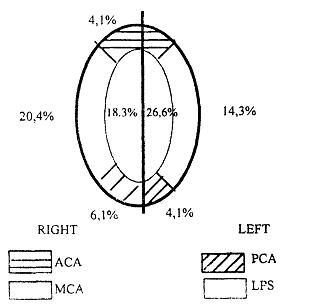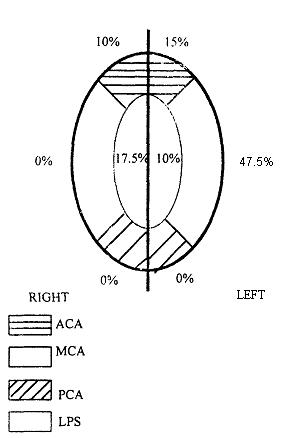
|
||||||||||||||||||||||||||||||||||||||||||||||||||||||||||||||||||||||||||||||||||||||||||||||||||||||||||||||||||||||||||||||||||||||||||||||||||||||||||||||||||||||||||||||||||||||||||||||||||||||||||||||||||||||||||||||||||||||||||||||||||||||||||||
|
CLINICAL STUDIES / ETUDES CLINIQUES
C.T. SCAN FEATURES IN STROKE IN THE URBAN BLACK AFRICANS
ASPECTS SCANNOGRAPHIQUES DANS UNE COMMUNAUTÉ URBAINE NOIRE AFRICAINE
LELO T.
1
SUMMARY A review of 154 black African patients with stroke checked with C.T. scan of the head over a period of five years shows that the ischemic attack is more frequent than the haemorrhagic one. The stroke involves mainly the territory of the middle cerebral artery and the lenticulo-pallido- strate arteries. The arterial hypertension is the most common aetiologic factor, followed by sickle cell disease, diabetes and some cardiovascular diseases. Keywords : Africa, Stroke, Black African, C.T. scan RESUME Dans une revue des 154 cas d’ AVC explores en tomodensitométrie sur une période de cinq ans dans une population noire urbaine, les auteurs notent que I’accident ischémique est plus fréquent que l’hémorragique. Les territoires de l’artère cérébrale moyenne et des artères lenticulo-pallido-striales sont les plus intéressés. L’HTA est le facteur predictif Ie plussouvent retrouve, suivi de l’anémie à cellules falciformes, du diabète et d’autres maladies cardio-vasculaires. Mots cles: Afrique, CT scan, tomodensotométrie INTRODUCTION The cerebio-vascular stroke is responsible for the 6 per cent of morbidity and 12 per cent of adult mortality at the Kinshasa Hospital (11) and has become a real public health problem. (1, 11, 14, 17) MATERIALS AND METHODS From 1988 to 1993, 286 patients have been referred to the Radiological Department of the Kinshasa University Hospital to be investigated with C.T. scan for presumptive stroke. Out of 286 patients, ’54 were selected on the following criteria: The following parameters were considered in our study: RESULTS The age and sex distribution in relation to the type of stroke is shown in table 1: Table 1: Age and sex distribution in relation of type of stroke
The incidence of age was from 2 years to 92 years with an average age of 44 years( 43 years for men and 47 years for women). The highest incidence was in the fifth decade of life (41 to 50 years). The sex ratio was of one women for two men showing a high incidence in males. The incidence of the type of stroke shows a ratio of one haemorrhagic stroke to two ischemic strokes. It is interesting to note that in the first two decades of life the strokes were all ischemic in this series and that in the haemorrhagic 6 cases had a ventricular bleeding. Table 2 shows the hemispheric side and the vascular area involved in percent: Table 2 : Hemispheric side and vascular are involved in ischemic and haemoragic stroke
As shown in table 2 the ischemic strokes involve predominantly the left hemisphere (3 left to 1 right): there is no hemispheric difference in the haemorrhagic strokes.  Fig 2a. Distribution of vascular area involved in ischemic strokes. The haemorrhagic strokes are more frequent in the lenticulo-pallido-striate areas (44,9 per cent) and in the territory of the middle cerebral artery (34,7 per cent). The anterior cerebral artery and the posterioe cerebral artery are involved with the same incidence (10,2 per cent). A ventricular bleeding is associated in 10 per cent of cases of haemorrhages of the middle cerebral and lenticulo-pallido-striates arteries, ( see Fig. 2b).  Fig 2b. Distribution on vascular areas involved in haemorrhagic strokes Table 3 shows the age related aetiological factors in the patients of our series. Table 3 : Age related aetiological factors in stroke
() = Associate to HTA Hypertension is the commonest aetiological factor in 85.7 per cent ofcases( 83.8 per cent alone and 1,9 per cent in association with diabetes mellitus). Sickle cell anaemia in the commonest aetiological factor in teenagers (87.5 per cent); Diabetes mellitus is present in 5.8 per cent of cases (3.9 per cent alone and 1.9 per cent of cases associated with hypertension); cardiovascular diseases are present in 1.9 per cent of cases, whilst in two cases no aetiological factor could be found. DISCUSSION In accordance with other Authors (LABAUGE et all (7), VALLAT et all (17), GAUTHIER et all (4), this study shows that in our population the most common stroke is ischemic. The majority of our patients had the stroke between the age of 30 and 60 years with an avarage age of 44 years, age that is lower than in the overseas studies (2, 4, 6, 12, 18) but in accordance with the african studies (10, 11, 14, 15, 16) and seems to affect more the population with no medical facilties and low socio-economic status. Haemorrhagic strokes are present in all vascular area but predominantly in the territory of the middle cerebral artery (34 per cent) and in the territory of the lenticulo-pallido-striate arteries (44 per cent) with a total of almost 80 per cent of stroke in this particular areas. Although prevalent in the left hemisphere, and this should be investigated in larger series, the ischemic stroke involves also the areas of the middle cerebral and lenticulo-pallido-striate arteries in 75 per cent of cases. Several other studies confirms the high indicence of stokes in these arterial territories (1,4, 18, 19). Another research should try to understand the poor involvement of the territories of the posterior cerebral arteries in stroke. The arterial hypertension is the commonest aetiological factor in stroke also for BOUDOURESQUES et all (1) who finds an incidence of 67 -90 per cent of cases. NJOH (15) finds that hypertension is the second aetiological cause in stroke and MATUJA et all (10) in Tanzania finds that hypertension is responsible only for 43 – 45 per cent of strokes. COOPE et all (3) reported the beneficial effect of antihypertensive drugs on the control of stroke incidence. Diabetes mellitus has an incidence of 5.8 per cent similar to the incidence of diabetes in the general population of 5 per cent. This should be further investigated because macroangiopathy seems to be rare in the African (13) A policy of control of hypertension should be suggested to prevent the devastating effect of stroke mainly in the young population. REFERENCES
|
© 2002-2018 African Journal of Neurological Sciences.
All rights reserved. Terms of use.
Tous droits réservés. Termes d'Utilisation.
ISSN: 1992-2647